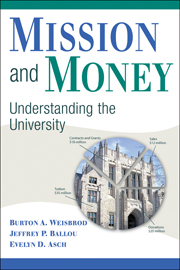Book contents
- Frontmatter
- Contents
- Illustrations
- Preface
- 1 An Introduction to the Higher Education Industry
- 2 The Higher Education Business and the Business of Higher Education – Now and Then
- 3 Is Higher Education Becoming Increasingly Competitive?
- 4 The Two-Good Framework: Revenue, Mission, and Why Colleges Do What They Do
- 5 Tuition, Price Discrimination, and Financial Aid
- 6 The Place of Donations in Funding the Higher Education Industry
- 7 Endowments and Their Management: Financing the Mission
- 8 Generating Revenue from Research and Patents
- 9 Other Ways to Generate Revenue – Wherever It May Be Found: Lobbying, the World Market, and Distance Education
- 10 Advertising, Branding, and Reputation
- 11 Are Public and Nonprofit Schools “Businesslike”? Cost-Consciousness and the Choice between Higher Cost and Lower Cost Faculty
- 12 Not Quite an Ivory Tower: Schools Compete by Collaborating
- 13 Intercollegiate Athletics: Money or Mission?
- 14 Mission or Money: What Do Colleges and Universities Want from Their Athletic Coaches and Presidents?
- 15 Concluding Remarks: What Are the Public Policy Issues?
- Appendix
- References
- Index
5 - Tuition, Price Discrimination, and Financial Aid
Published online by Cambridge University Press: 17 July 2009
- Frontmatter
- Contents
- Illustrations
- Preface
- 1 An Introduction to the Higher Education Industry
- 2 The Higher Education Business and the Business of Higher Education – Now and Then
- 3 Is Higher Education Becoming Increasingly Competitive?
- 4 The Two-Good Framework: Revenue, Mission, and Why Colleges Do What They Do
- 5 Tuition, Price Discrimination, and Financial Aid
- 6 The Place of Donations in Funding the Higher Education Industry
- 7 Endowments and Their Management: Financing the Mission
- 8 Generating Revenue from Research and Patents
- 9 Other Ways to Generate Revenue – Wherever It May Be Found: Lobbying, the World Market, and Distance Education
- 10 Advertising, Branding, and Reputation
- 11 Are Public and Nonprofit Schools “Businesslike”? Cost-Consciousness and the Choice between Higher Cost and Lower Cost Faculty
- 12 Not Quite an Ivory Tower: Schools Compete by Collaborating
- 13 Intercollegiate Athletics: Money or Mission?
- 14 Mission or Money: What Do Colleges and Universities Want from Their Athletic Coaches and Presidents?
- 15 Concluding Remarks: What Are the Public Policy Issues?
- Appendix
- References
- Index
Summary
To a college or university, tuition is a major, if not the principal, source of revenue for financing its mission. It is also the principal instrument used by a school to influence which students attend that school and, thus, the peers that a school can offer as an attraction to prospective students. Put another way, tuition plays the dual role of helping to raise funds while simultaneously serving as a mechanism for attracting the particular mix of students the school wants in advancing its mission.
The key to this dual role, as we shall see below, is that the notion of a school's “tuition” is less clear-cut than it may first appear. Although one typically associates a single number with a school's undergraduate tuition (the listed tuition), the actual prices that students pay to take classes (the net tuition) vary from student to student. Indeed, it is quite common for two students in the same major and taking identical classes to pay different net tuitions in the same way that two people sitting next to one another on a plane flight likely paid different prices for their tickets. The reasons for the differential pricing may differ, however. For the airline the price “discrimination” is simply geared to a profit-maximizing strategy, whereas for a public or private nonprofit school it is aimed at both revenue and student mix.
- Type
- Chapter
- Information
- Mission and MoneyUnderstanding the University, pp. 77 - 101Publisher: Cambridge University PressPrint publication year: 2008

